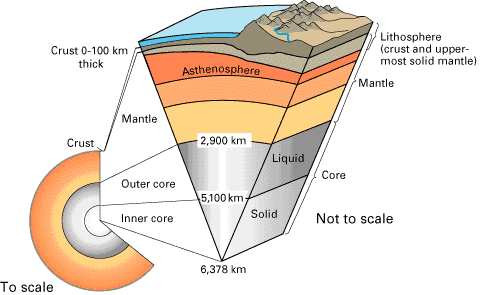
INTERNAL EARTH STRUCTURE REVIEW QUESTIONS
NAME: ___________________________ PER: ______ DATE:________________
The class was divided into three classettes. One classette at a time will work with your teacher on the calculations for the SEISMIC DISCOVERY INVESTIGATION (http://www.oocities.org/CapeCanaveral/7639/internal/seismic2.htm). Another sub-class will start their Internal Earth Evidence Scrapbook (http://www.oocities.org/CapeCanaveral/7639/internal/howdoweknow.htm), and your classette is using the computers to find information online. Everyone will change tasks 1/3 of the way through the class period.
If you painted a basketball with a single coat of paint, the thickness
of that paint could represent the thickness of the crust of the Earth. The
deepest hole ever drilled into our planet did not even penetrate the crust. The
deepest mines do not go anywhere near the bottom of the crust. We have no
samples of rock from taken directly from anyplace inside the Earth except the
top of the crust. In spite of this, we know a great deal about the interior of
the Earth from indirect methods especially the way that seismic waves
(vibrations from earthquakes) travel through it. As part of your introduction to
the Internal Earth Processes and Products section of the course, your task is to
find out how humans know about what is inside the planet. The questions that
follow cover the knowledge you need to acquire while you do this.
except the
top of the crust. In spite of this, we know a great deal about the interior of
the Earth from indirect methods especially the way that seismic waves
(vibrations from earthquakes) travel through it. As part of your introduction to
the Internal Earth Processes and Products section of the course, your task is to
find out how humans know about what is inside the planet. The questions that
follow cover the knowledge you need to acquire while you do this.
Here are some sources of information to help you (be sure to preview them all THEN start with the one that can help the most):
- The pictures on your Internal Earth Evidence Scrapbook (http://www.oocities.org/CapeCanaveral/7639/internal/howdoweknow.htm) are links to the web pages they came from.
- A good introductory video is: The Earth's Interior; part of The Earth Revealed Series from Annenburg CPB. You have to register (for free) to view the videos at this site. An optional series of questions for this video is at: http://www.oocities.org/CapeCanaveral/7639/internal/intrnlvd.htm.
- The US Geological Service has a lot of information, especially useful is Inside The Earth, part of their This Dynamic Earth website. The graphic on this page is from their site.
- Two notetaking guides you can use are Seismic Evidence for Earth's Internal Structure and NON-SEISMIC EVIDENCE FOR INTERNAL EARTH STRUCTURE
- A good website with animations is How Do We Know about Layers Deep within Earth?, part of the Exploring Earth website. Especially useful are Observe animations of earthquake waves and Locating Layers
 1. How do we know that there is a distinct boundary between the crust and
mantle?
1. How do we know that there is a distinct boundary between the crust and
mantle?
2. How do we know that the density of the Earth generally increases with depth?
3. How do we know that the asthenosphere is there?
4. How do we know that the outer core is liquid?
5. How we know that Earth has a solid inner core?
6. How do we know the dimensions of the cores, mantle, asthenosphere, and crust?
7. How do we know that the core of the Earth is very hot?
8. How do we know that the cores are made of iron?
9. How do we know that convection currents occur in the mantle?
10. Use the back of the paper to draw and label a cross section of the Earth illustrating all the above features.